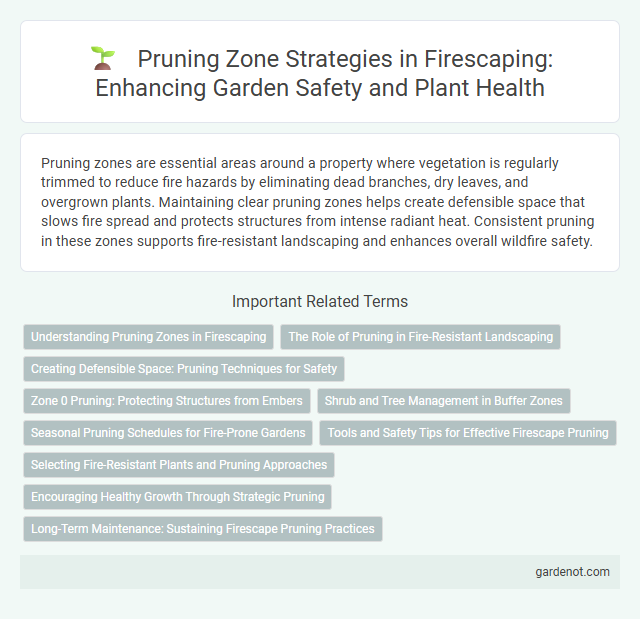Pruning zones are essential areas around a property where vegetation is regularly trimmed to reduce fire hazards by eliminating dead branches, dry leaves, and overgrown plants. Maintaining clear pruning zones helps create defensible space that slows fire spread and protects structures from intense radiant heat. Consistent pruning in these zones supports fire-resistant landscaping and enhances overall wildfire safety.
Understanding Pruning Zones in Firescaping
Pruning zones in firescaping are designated buffer areas around structures where vegetation is carefully managed to reduce wildfire risk. This involves removing dead branches, thinning dense foliage, and maintaining low-growing plants to create defensible space that slows fire spread. Understanding the specific requirements and recommended distances for pruning zones is critical for enhancing property protection and promoting fire-resistant landscapes.
The Role of Pruning in Fire-Resistant Landscaping
Pruning plays a critical role in fire-resistant landscaping by reducing fuel load and minimizing the risk of fire spread within the pruning zone. Strategic removal of dead branches, thinning dense foliage, and maintaining adequate spacing between plants disrupts fire continuity and enhances defensible space. Proper pruning also promotes plant health and resilience, contributing to a landscape better equipped to withstand wildfires.
Creating Defensible Space: Pruning Techniques for Safety
Pruning within the defensible space zone involves selectively removing lower branches, dead vegetation, and dense foliage to reduce fuel continuity and slow wildfire spread. Techniques such as thinning crowded branches and limbing up trees create vertical and horizontal separation between plants, enhancing firefighter access and improving safety. Consistent maintenance of pruning zones helps establish a fire-resistant barrier, crucial for protecting structures and minimizing fire intensity.
Zone 0 Pruning: Protecting Structures from Embers
Zone 0 pruning involves removing dead branches, leaves, and other flammable materials within 5 feet of a structure to reduce ember fire risk. Maintaining a minimum 10-foot clearance between tree canopies and the roof prevents embers from igniting vulnerable areas. Consistent inspection and pruning in this zone create a defensible space critical for protecting homes during wildfire events.
Shrub and Tree Management in Buffer Zones
Pruning in buffer zones is essential for maintaining healthy shrub and tree growth while reducing wildfire risk by removing dead or overgrown branches and promoting proper airflow. Targeted shrub and tree management improves fire resistance by reducing fuel buildup near structures and maintaining defensible spaces. Regular inspection and strategic pruning enhance plant vitality and ensure buffer zones effectively slow wildfire spread.
Seasonal Pruning Schedules for Fire-Prone Gardens
Seasonal pruning schedules for fire-prone gardens focus on reducing deadwood and excess foliage during late winter and early spring to minimize fuel load before peak fire season. Pruning in these key periods helps maintain a defensible space by improving plant health and reducing fire intensity risks associated with dense vegetation. Regular monitoring and timely removal of dry, flammable material are essential components of an effective firescaping strategy.
Tools and Safety Tips for Effective Firescape Pruning
Use sharp hand pruners, loppers, and pruning saws designed for clean cuts to maintain plant health and prevent fire hazards in the pruning zone. Wear protective gloves, safety goggles, and long sleeves to avoid injuries from sharp tools and thorny plants during firescape pruning. Regularly disinfect tools to prevent disease spread and always dispose of pruned debris away from structures to reduce flammable material buildup.
Selecting Fire-Resistant Plants and Pruning Approaches
Selecting fire-resistant plants such as manzanita, ceanothus, and California lilac within the pruning zone reduces fuel for wildfires and enhances landscape resilience. Employing strategic pruning approaches like thinning dense foliage and removing dead branches minimizes fire hazards by improving air circulation and limiting combustible material. Regular maintenance ensures these plants maintain their fire-resistant characteristics, creating an effective barrier against wildfire spread.
Encouraging Healthy Growth Through Strategic Pruning
Pruning zones play a critical role in firescaping by reducing fuel load near structures and promoting fire-resistant landscapes. Strategic pruning encourages healthy growth by selectively removing dead or overgrown branches, improving air circulation, and enhancing plant vigor, which increases resilience to fire stress. Maintaining a well-pruned zone within 30 feet of buildings is essential for minimizing fire hazards and supporting sustainable, fire-adapted vegetation.
Long-Term Maintenance: Sustaining Firescape Pruning Practices
Sustaining firescape pruning practices within the Pruning zone requires consistent removal of dead or overgrown vegetation to reduce fuel loads and maintain defensible space. Long-term maintenance involves scheduled inspections and selective trimming to encourage healthy plant growth while minimizing fire hazards. Implementing adaptive pruning techniques supports ecosystem resilience and enhances landscape safety over time.
Pruning zone Infographic

 gardenot.com
gardenot.com